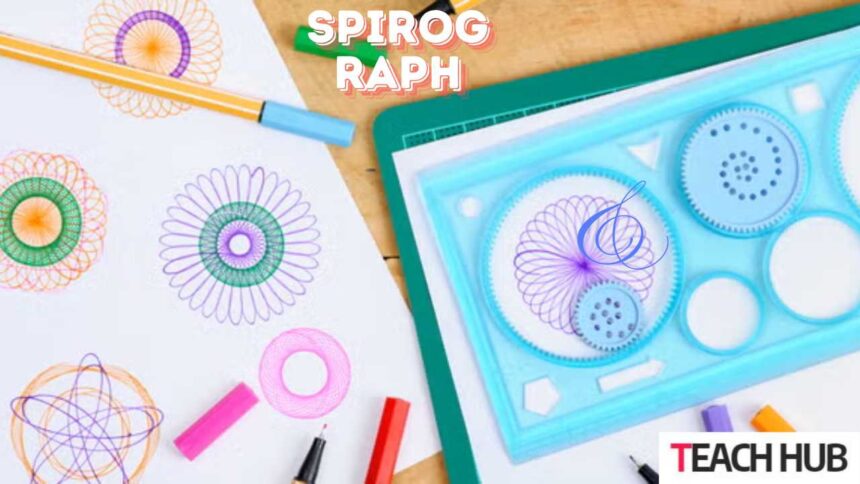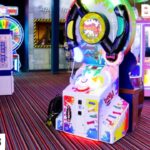British engineer Denys Fisher invented the Spirograph in the early 1960s. Initially designed as a tool to illustrate mathematical curves, it quickly gained popularity as a fascinating drawing toy. Introduced to the public in 1965, Spirograph sets captivated children and adults with their ability to create intricate geometric patterns. Inspired by earlier devices like the harmonograph, the design combined simple mechanics with artistic expression, making it a staple in educational and recreational settings.
How Does a Spirograph Work?
A Spirograph operates using gears and wheels that interlock in various configurations. When a pen is placed in one of the holes of a gear and moved around the perimeter of another fixed gear, it produces a continuous series of curves known as hypotrochoids and epitrochoids. The interaction between the rotating gear and the stationary gear dictates the shape and complexity of the resulting pattern. This process allows for endless variations and unique designs, making each creation distinct.
Essential Components of a Spirograph Set
A typical Spirograph set includes several key components:
Plastic gears.
Various-sized rings.
A few pens or markers.
A base or drawing surface.
The gears come in different shapes and sizes, each with multiple holes for the pen. The rings act as guides, holding the gears in place while they rotate. Some sets also include putty or adhesive to secure the rings to the drawing surface, ensuring stability. These elements work together to create the mesmerising patterns associated with Spirograph art.
The Science Behind Spirograph Patterns
Spirograph patterns result from complex mathematical equations involving the gears’ radii and the pen’s position. The shapes produced, called hypotrochoids and epitrochoids, are derived from the mathematical study of curves and motion. When a smaller gear rotates inside or around a larger ring, the pen traces paths these relationships determine. Understanding the underlying geometry and mathematics can enhance appreciation for the intricate designs and inspire new variations.
Step-by-Step Guide to Creating Spirograph Art
To create Spirograph art, select a gear and a corresponding ring. Place the ring on your drawing surface and secure it if necessary. Choose a hole in the gear, insert a pen, and fit the gear inside or around the ring. Begin to rotate the gear, keeping steady pressure on the pen. Move slowly and consistently to ensure smooth lines. Experiment with different gears, rings, and pen positions to discover a variety of patterns. Practice will improve precision and creativity.
Tips and Tricks for Perfect Spirograph Designs
Achieving perfect Spirograph designs involves some practice and a few helpful techniques. First, ensure your drawing surface is stable to avoid slipping. Use fine-tip pens for detailed patterns and bolder pens for larger, more visible designs. Experiment with different colour combinations to enhance the visual appeal. Keep your gears clean and free of debris to maintain smooth movement. Finally, practise steady hand movements and consistent pressure to avoid line breaks or inconsistencies.
Exploring Advanced Spirograph Techniques
Once you’ve mastered the basics, exploring advanced Spirograph techniques can lead to even more intricate and stunning designs. Try layering multiple patterns on each other using different colours for a 3D effect—experiment with varying the pen pressure and speed to create dynamic line thicknesses. Combine gears and rings in unconventional ways to discover new patterns. Use additional artistic tools, such as shading and colouring, to enhance the complexity and depth of your Spirograph art.
Benefits of Using a Spirograph for Children and Adults
Spirograph offers numerous benefits for both children and adults. For children, it aids in developing fine motor skills, hand-eye coordination, and understanding of geometric concepts. It encourages creativity and patience. Adults find it a relaxing and meditative activity that can reduce stress and promote mindfulness. Additionally, Spirograph can be a tool for teaching mathematics and art, making it both educational and entertaining.
Spirograph Art in Modern Creative Projects
Spirograph art has found its place in modern creative projects, transcending its origins as a simple drawing toy. Artists and designers use Spirograph patterns in various media, including digital art, textiles, and home décor. The timeless appeal of geometric designs makes them suitable for contemporary aesthetics. Spirograph patterns are also incorporated into graphic design, creating unique logos, backgrounds, and illustrations that stand out in visual media.
Where to Buy Spirograph Sets and Accessories
Spirograph sets and accessories are widely available in toy stores, craft stores, and online marketplaces. Popular retailers like Amazon, Walmart, and Target offer a range of Spirograph products, from classic sets to deluxe editions with additional components. Specialty art and educational stores may carry unique and high-quality sets. When purchasing, consider the variety of gears and rings included and the quality of the materials to ensure a satisfying and durable Spirograph experience.
Conclusion
The Spirograph is a fascinating blend of art and mathematics that has captivated people for decades. Its ability to create intricate and unique patterns makes it a timeless tool for artistic expression and educational exploration. Whether you’re a child discovering geometric art for the first time or an adult seeking a creative and relaxing pastime, the Spirograph offers endless possibilities. Embrace the magic of Spirograph and let your imagination guide your artistic journey.
(FAQs)
Spirograph is a drawing toy that uses interlocking gears and wheels to create intricate geometric patterns. It was invented in the 1960s by British engineer Denys Fisher and has since become famous for educational and recreational purposes.
How can I create Spirograph art?
To create Spirograph art, select a gear and a ring, place the ring on your drawing surface, and secure it if necessary. Insert a pen into a hole in the gear, fit the gear inside or around the ring, and begin to rotate the gear while applying steady pressure. Experiment with different gears and rings to produce various patterns.
What are some tips for perfect Spirograph designs?
To achieve ideal spirograph designs, use a stable drawing surface, fine-tip pens for detailed patterns, and experiment with colour combinations. Keep your gears clean and practice steady hand movements with consistent pressure to avoid line breaks.
Are there advanced techniques for using a Spirograph?
Yes, advanced Spirograph techniques include:
- Layering multiple patterns with different colours.
- Varying pen pressure and speed.
- Combining gears in unconventional ways.
- Use shading and colouring to enhance the complexity of your designs.
What are the benefits of using a Spirograph for children and adults?
Spirographs help children develop fine motor skills, hand-eye coordination, and understanding of geometric concepts. They also encourage creativity and patience. Adults find them relaxing and meditative, helping to reduce stress and promote mindfulness. Spirographs can also be used as teaching tools in both art and mathematics.
How is Spirograph art used in modern creative projects?
Spirograph art is incorporated into various modern creative projects, including digital art, textiles, home décor, and graphic design. Its geometric patterns are timeless and versatile, making them suitable for contemporary aesthetics and unique visual media applications.
Where can I buy Spirograph sets and accessories?
Spirograph sets and accessories can be purchased from toy stores, craft stores, and online marketplaces like Amazon, Walmart, and Target. Speciality art and educational stores may also carry unique and high-quality sets. When buying, consider the variety of gears and rings included and the quality of the materials.



